National University’s own Melvin Collins, LLD, was recently honored with a brick placed in a walkway leading to the Admiral Nimitz Museum, part of the Pacific War Museum in Fredericksburg, Texas. Mel’s brick is surrounded by bricks naming other shipmates from the U.S.S. Franks. Both Mel and the USS Franks played a unique role in naval history.
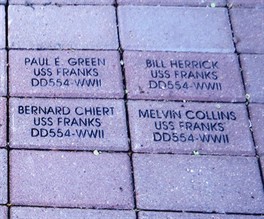 During World War II, Melvin Collins and the USS Franks changed the way the navy rescued downed pilots at sea. When pilots were shot down in battle, ships like the USS Franks, would deploy small boats to rescue them. This proved a slow process, as the boats took a great deal of critical time to be lowered into the water.
During World War II, Melvin Collins and the USS Franks changed the way the navy rescued downed pilots at sea. When pilots were shot down in battle, ships like the USS Franks, would deploy small boats to rescue them. This proved a slow process, as the boats took a great deal of critical time to be lowered into the water.
To counter this frustrating time delay, Mel and his captain devised a new method: Mel would dive from the ship’s deck and swim out to the downed plane to rescue the pilot directly. With a rope strapped around his waist to tether him to the ship, and a knife at his waist to fend off sharks and cut pilots out of their safety harnesses, Mel saved 23 pilots in this manner, earning him the Bronze Star as well as the Navy and Marine Corps Medal.
You can read a gripping story of Mel’s heroic and groundbreaking rescue efforts, chronicled in “A Sailor’s Diary” (see below) by Brian T. Murphy,
Mel is also honored at the World War II Memorial in Washington, DC. Recently turning 90 years old, he continues to serve the university as alumni outreach coordinator in the NUHS department of admissions.
The following story which chronicles the heroic war service of National University of Health Sciences staff member Melvin J. Collins, is reprinted with permission:
A Sailor’s Diary
by Brian T. Murphy
(Brian T. Murphy is a freelance writer and photographer from Midway, Utah)
One World War II sailor risked death on the high seas to invent a way to rescue downed airmen.
More than 60 years after it was written, Melvin J. Collins’ diary arrived in my mailbox. It was sealed in a padded envelope. The weathered volume was small enough to squeeze into the back pocket of a sailor’s denims, which is where I imagine he stowed it during his tour aboard the USS Franks. The faded blue jacket was worn, spotted with oil and badly frayed around the edges. With tens of thousands like it, the book had been printed during World War II and issued to servicemen to record their grand adventure – “a token of appreciation for your service to our country,” it said inside the cover. While others tossed theirs aside, Mel filled his with a fascinating firsthand account of the war in the Pacific and his unique place in its history. Written in pencil, the words seemed to have faded with each reading.
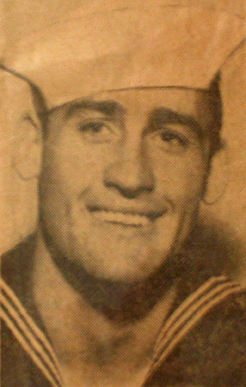 I settled into a wicker chair on our back porch and read the first page:
I settled into a wicker chair on our back porch and read the first page:
Melvin J. Collins, Ottumwa, Iowa. Born September 4, 1924. Entered the Navy April 2, 1943.
Tattoo on left arm, 5′ 10”, 155 pounds, blue eyes and brown hair.
The first dated entry brought a smile.
“July 15-16: Went to a fortune-teller. Real nice. Had a lot of fine things to say. Hope they come to pass!”
Only 18 years old, Mel began his extraordinary odyssey as a radarman third class aboard the Franks, a destroyer – or “tin can,” as they called them. No fortune-teller could have predicted the defining role the young sailor would play during the horrific naval engagements of the Pacific War. His first battle entry was recorded in November 1943:
“Saw aircraft carrier sunk on November 23 in the Gilbert Islands by Jap sub at 5:00 a.m. – a sight I’ll never forget. That night attacked by Jap sub and planes-dropping flares…”
And so it began. By December, the Franks was operating with the 5th Fleet and had survived hostilities in Tarawa in the Gilbert Island Group. As general workhorses for the fleet, destroyers also served as primary rescue vessels for downed carrier pilots. Deployed 2,000 yards astern of a carrier during flight operations, destroyers stood ready for any contingency. When an aircraft crashed into the sea, a destroyer rushed to the scene, came to a full stop and launched a whaleboat. More often than not, the pilot and crew – trapped in the doomed plane – would sink beneath the waves before they could be saved.
During the Tarawa campaign, the Franks was ordered to render assistance to a navy attack plane that had been downed by enemy gunfire. The sea was particularly heavy, rough waves tossing the vessel every which way. Aware of Mel’s Red Cross lifesaving skills, the captain decided to try something bold. Rather than stand by during a painfully slow launch of the whaleboat, he ordered the sailor to attempt a swimming rescue. Mel made the following entry in his diary, redefining forever the way downed pilots would be rescued in the open sea:
“… Avenger goes down after bombing. Waves plenty big – ship is really rolling. Too rough to go after them in a boat so officer let me rescue them. Tied a rope around my waist and dove off forecastle and swam to the plane – exhausted – saw to one who was going down. I towed him in and put him in a stretcher that was over the side of the ship, then went and got the other two who were ‘OK.’ All three pilots saved. Officer congratulated me afterwards – I was the big boy for a couple of days. The boys I saved thanked me and said I got there just in time.”
Mel received the Bronze Star for his heroics, and the Franks became the first destroyer to use a swimmer to rescue downed pilots. News traveled fast, and before long all the carriers were requesting the Franks to watch over their pilots. January found the ship in the Kwajalein Islands, where Mel’s diary describes the 800 ships assembled, then Guadalcanal in March, Bougainville in June, Guam in July, and finally Leyte Gulf during October 1944 – MacArthur’s return to the Philippines. The Franks had earned nine battle stars before the war’s end, and Mel had performed his swimming rescues over and over – an extraordinary feat.
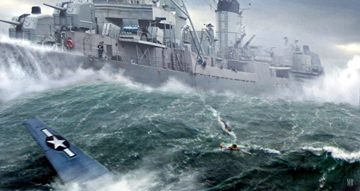 Following the success of Mel’s first rescue, the Franks crew worked feverishly to refine the technique. Rigged for a mid-ship rescue, Mel was outfitted with a leather belt that had a “D” ring sewn into the back so a lifeline could easily be attached. There was a sheath for a knife to fight off sharks, while sharpshooters stood watch at the rail whenever Mel dove in, looking for fins of swarming sharks drawn by blood from bleeding pilots and cuts from razor-sharp barnacles on the ship’s hull.
Following the success of Mel’s first rescue, the Franks crew worked feverishly to refine the technique. Rigged for a mid-ship rescue, Mel was outfitted with a leather belt that had a “D” ring sewn into the back so a lifeline could easily be attached. There was a sheath for a knife to fight off sharks, while sharpshooters stood watch at the rail whenever Mel dove in, looking for fins of swarming sharks drawn by blood from bleeding pilots and cuts from razor-sharp barnacles on the ship’s hull.
In addition to occasional strafing by enemy pilots while exposed in the open sea, Mel dealt with other hazards. On one occasion, a Corsair returning from a strike crashed nearby, and Mel was sent in after the pilot. The Franks still had headway as it approached the plane, so the captain put the engines full speed astern with Mel in the water.
“… I was drawn under the water by the screws … the guys holding my line said it tangled in the guard rail and that saved me from the screws – they thought the line was going to break but it didn’t. I finally came to the surface after taking a lot of water then… it took me under again, rolling me like a top. I thought for sure I was a goner. Air all gone, I had strength for one more stroke and thank God I broke to the surface. I got some air and tried to wave but they didn’t see me and under I went again. Nothing I could do. Finally the guys hollered to the captain to stop, I was weak and ready to drown… never got to the pilot…”
A swimming rescue required Mel to dive 15 feet from the deck of the Franks into the open sea, then battle cresting waves to reach the downed aircraft – sometimes 100 yards away – before it sank. If he was successful, he was towed back carrying the dead weight of an unconscious pilot and his flight gear. A stretcher was lowered to water level with 5-inch powder casings attached to the side that allowed it to float – a device contrived by an engineer aboard the Franks. Once the pilot was inside the stretcher, he was hauled aboard. Mel was always last, winched up in a boatswain’s chair.
Although it was wartime, rescues became a game for Mel and the Franks crew as they timed each attempt, always trying to beat their best effort. A successful rescue was an occasion for rejoicing. It meant that once the carrier had received its pilot back aboard, 20 gallons of ice cream would be sent over to the crew of the Franks – the only ice cream they had when they were at sea.
Mel came from an extremely poor family. He grew up during the Depression, with little to eat. The local YMCA became his home away from home, where he found buddies who were better off and shared their lunches with him. It was at the YMCA that Mel developed into a well-rounded athlete. An outstanding swimmer, they called him a squid, later nicknaming him “squib” – no one know why the change. It was his swimming ability honed at the “Y” that empowered him to rescue pilots in all sorts of weather, even typhoons. In spite of Mel’s extraordinary athleticism, not all rescue attempts had happy endings. His diary entry Jan. 10:
“Rescued pilot from an Avenger. Only one got out. Lost other two. Bad weather; swells like mountains – 50 feet.”
Still, Mel enjoyed his fair share of success:
“Feb. 8. Awarded Navy and Marine Corps Medal.”
“Feb. 17. After raids on Tokyo one fighter from a Hellcat crashed… I rescued him in really cold water and also wind that was so bad that all hands were wearing fur lined coats and pants. Water really cold. After I got back aboard the captain told all hands, ‘hats off to Collins.’ A cruiser sent us a message and said ‘congratulations on fast rescue. If all ships used your method there would be more pilots alive today.’ Quite a compliment. Sent our method of swimming rescue to Navy Department, also to all ships in the fleet.”
In 1945, the famous journalist Ernie Pyle watched the rescue of his good friend Jimmy Van Fleet, an F6F pilot, from the decks of the aircraft carrier USS Cabot. He described the experience in his book, “The Last Chapter.”
“…Jimmy had hardly hit the water when we saw a destroyer heel over in a swath-cutting turn. They had been watching the takeoffs through their glasses, and had seen him go over. Our own ship, of course, had to keep going straight ahead… the destroyer had Jimmy aboard in just seven minutes. They didn’t put over a boat for him, but instead sent a swimmer out with a line tied around his waist. He got there just in time; Jimmy passed out in his arms. …Destroyers keep a box score… and try to set a new record. Their record rescue was three minutes… this particular destroyer had fished out so many pilots that they had a scroll already printed up, and all they had to do was fill in the name… We got Jimmy aboard and then sent twenty gallons of ice cream back across in the chair… the swimmers were Seaman First Class Franklin Calloway… and… Radarman Third Class Melvin Collins of Ottumwa, Iowa.”
Melvin J. Collins was discharged from the Navy in November 1945. Before his discharge, the highly decorated sailor received a letter from his mother. She told him that she had awakened from a dream in which she was surrounded by water and was drowning. It was dated the same day as one of Mel’s most difficult rescues.
Mel’s brother, Jim, a sailor on the USS Lexington, also received the Navy and Marine Corps Medal for rescuing a pilot from a burning plane. Likewise, their mother wrote Jim that she’d awakened from another dream where she was surrounded by fire and couldn’t get out – half a world apart – and also at the exact time the event happened.
After the service, Mel entered Coe College on the GI bill. Along with three other varsity letters, he lettered in golf without ever owning a set of clubs or golf shoes – beating all the country-club boys with borrowed equipment.
After he graduated from college, he worked as a high school teacher and coach and, not surprisingly, as a YMCA physical director.
As of this writing, after 30 years as a college counselor, Mel still works part-time at the National University of Health Sciences in Lombard, IL, where he was inducted into its Hall of Fame in 2001.
The Rest of the Story:
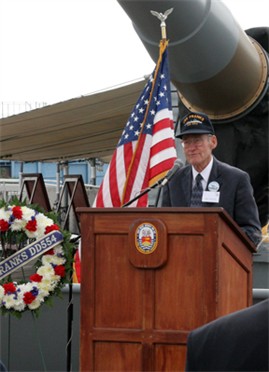 In September 2007, Mel traveled to Camden New Jersey for a reunion with 12 of his former shipmates. They gathered to visit the battleship USS New Jersey at the Battleship New Jersey Memorial and Museum. There, they held a memorial service for the captain of their destroyer, the Franks, who was killed one stormy night in the Pacific Ocean when the USS New Jersey accidentally sideswiped their much smaller ship.
In September 2007, Mel traveled to Camden New Jersey for a reunion with 12 of his former shipmates. They gathered to visit the battleship USS New Jersey at the Battleship New Jersey Memorial and Museum. There, they held a memorial service for the captain of their destroyer, the Franks, who was killed one stormy night in the Pacific Ocean when the USS New Jersey accidentally sideswiped their much smaller ship.
The New Jersey’s anchor tore into the navigation bridge, causing the Franks’ captain to fatally fall from the bridge to the main deck. Collins recalled that the impact of the collision knocked him onto the floor of the interior of the Franks’ bridge. “When I crawled outside onto the bridge wing and looked up, all I saw was open sky and no captain.”
Until September’s reunion, Mel had never stepped foot on the battleship that tore through his own destroyer that dark night so long ago. Mel’s response to media covering the event was, “It is really so nice to meet the New Jersey formally since we met it so informally 61 years ago.”
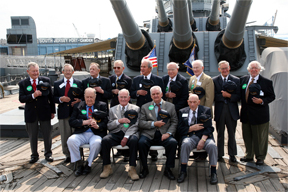
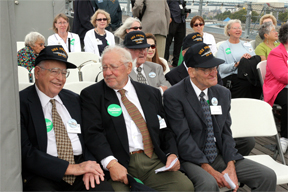

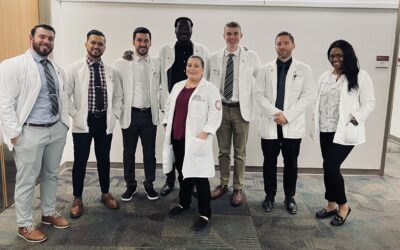


0 Comments